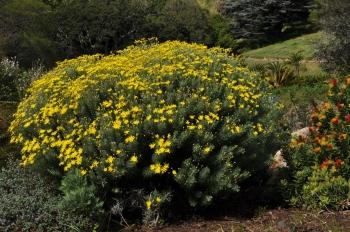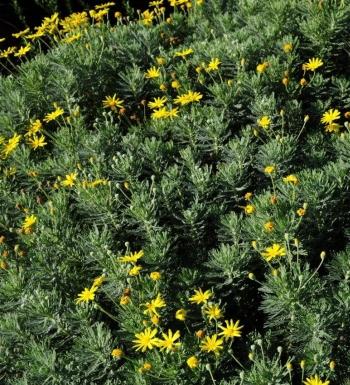Euryops ‘Silver Sunshine’
Euryops ‘Silver Sunshine’
Family: Asteraceae
Common names: ‘Silver Sunshine’ resin bush (Eng.); ‘Silver Sunshine’ harpuisbos (Afr.)
Introduction
This Euryops hybrid was discovered in full bloom in Kirstenbosch National Botanical Garden, much to the delight of the horticulturists, as it is a beautiful, densely and naturally rounded, free-flowering creation of its own making that is eye-catching, with silvery grey foliage and masses of compactly clustered, bright yellow daisy flowers.

Description
Description
A fast-growing, evergreen shrub, up to 1.5 m high, with attractive, deeply lobed, comb-like leaves, densely covering the branches from base to tips. Masses of single, bright yellow daisies are held above the leaves, on thin stalks, covering the bush so thickly in peak flowering, that the foliage is not visible.

Flowers occur mainly in winter, from late summer to early spring (March to September) but flowers can be found on the bush throughout the year. These dazzling flower heads are daisy-like, with bright yellow ray petals and deeper yellow centres. Numerous small, black sunflower-like seeds are produced after flowering.
Conservation Status
Status
Euryops ‘Silver Sunshine’ is a garden hybrid and it has no natural habitat and thus, no Red List status.
Distribution and habitat
Distribution description
This hybrid was created naturally, by the pollinators, in Kirstenbosch National Botanical Garden. The only parent we can identify with certainty is Euryops pectinatus (woolly resin bush), as this was the only species of Euryops planted in the garden bed where the hybrid was discovered. The other parent could be one of the many other Euryops planted throughout Kirstenbosch. After much debate and discussion amongst the horticulturists, the most likely suspect for the second parent is considered to be Euryops abrotanifolius (lace-leaf resin bush), as it is known for its variable forms, profusion of flowers and denseness of foliage, and it is the only other species of Euryops in the garden that shares a similar habitat and distribution as E. pectinatus.
Euryops pectinatus occurs on rocky, sandstone slopes in the Western Cape, from Gifberg to the southern Cape Peninsula. Euryops abrotanifolius occurs on sandy or stony mountain slopes and hillsides, usually sandstone, in the Northern and Western Cape from the northern Cedarberg to the Langeberg Mountains, including the Cape Peninsula where it is quite common.
The other potential parents that are planted in Kirstenbosch include:
Euryops chrysanthemoides, which occurs in the Eastern Cape, along the coast and inland, to KwaZulu-Natal, Mpumalanga and Swaziland.
Euryops linearis (De Hoop resin bush), which is endemic to the area between Bredasdorp and De Hoop, in the Western Cape, on limestone hills.
Euryops virgatus (Nieuwoudtville resin bush), which is found in Nieuwoudtville, Northern Cape.
Euryops virgineus (river resin bush), which occurs naturally in the southern coastal areas from Bredasdorp in the Western Cape to Alexandria in the Eastern Cape, extending inland into the Swartberg Mountains.
Derivation of name and historical aspects
History
Euryops is derived from the Greek, eurys, meaning ‘large’ or ‘wide’, and ops, meaning ‘eye’ or ‘face’, referring to the large, showy flower heads. Its cultivar name ‘Silver Sunshine’ refers to the silvery grey foliage and to the profusion of bright yellow flowers.
The common name harpuisbos, means resin bush and is applied generally to most species of Euryops. It is a direct translation from the Dutch name harpuis bosch from the Dutch word hars, meaning 'resin' and puisje 'small pustule', referring to the resinous discharge in many of the species that oozes from the stem and branches, in the form of small rounded drops.
The genus Euryops consists of 97 species, which occur through southern and tropical Africa, as well as in Saudi Arabia. There are 89 species in southern Africa, where they are widespread, with approximately 30 that occur within the fynbos. Besides those mentioned above, these species are also grown at Kirstenbosch: E. tysonii, E. annae (small resin bush), E. speciosissimus (Clanwilliam resin bush) and Euryops chrysanthemoides x pectinatus ‘Kirstenbosch’.
Many Euryops are easy to grow, ornamental shrubs, well-suited for use in landscaping and the home garden.

Ecology
Ecology
This plant is well adapted to summer drought, full sun conditions and wind. It has 3 major adaptations that make it waterwise: the grey colour of the foliage that reflects the heat and sunlight; the velvety texture of the leaves and the denseness of the foliage, both reducing evaporation by providing self-shading and rebuffing of wind.
The masses of bright yellow daisy flowers attract butterflies, beetles, bees and other pollen-seeking insects, which in turn lure the insectivorous birds. Seed-eating birds will eat the seeds.
Uses
Use
Euryops ‘Silver Sunshine’ is not yet well known in horticulture, and is only just becoming available in nurseries in the Western Cape. It shows considerable horticultural potential, as a quick-growing, display shrub.
The daisies last well in small flower arrangements, and combine well with the cheerful blue and yellow of Felicia blooms.

Growing Euryops ‘Silver Sunshine’
Grow
As Euryops ‘Silver Sunshine’ is a hybrid, in order to retain all its characteristic qualities it should only be propagated by making cuttings. Seed sown will not be clones of ‘Silver Sunshine’ and so will exhibit characteristics of both the parent plants instead. Propagate in autumn from stem cuttings. Take cuttings in the early morning before the plants begin to actively transpire in the heat of the day, as this lessens the amount of stress the cuttings will be under and increases the chances of propagation success. Dip the cuttings in a hormone powder/solution to increase the rooting percentage and place in a suitable medium under moist (but not wet) conditions, until the roots form. A variety of rooting mediums can be used, as long as they are well drained (sand, bark, palm fibre or vermiculite are all suitable). The cuttings root easily in approximately 4 weeks. Once the rooted and the cuttings have been hardened off, pot up the plantlets into any average, well drained potting soil. Once the young plants are well established, plant out into the garden.
It is easy and undemanding plant in the garden, fast growing and on condition it is planted in a full sun position, it flowers freely. It does best in well-drained, sandy soil with regular applications of compost, but will tolerate a wide range of soil types and still perform well.
Prune back lightly anytime, but usually to best effect after the main flush of flowering, by removing old flowers and nipping back growth tips to encourage new growth and further batches of flowers. Old plants can be rejuvenated by being cut back very hard and they will resprout from the base.
Plant in groups of 3 or 5 for maximum impact in a garden, providing a bright splash of yellow when in flower and a lovely grey contrast effect with the silvery foliage when not flowering. Single accent plants are also striking when in flower.
Euryops ‘Silver Sunshine’ has no serious pests.
References
- Eliovson, S. 1973. South African wild flowers for the garden. Macmillan, Johannesburg.
- Joffe, P.1993. The gardener’s guide to South African plants. Tafelberg Publishers, Cape Town.
- Joffe, P. 2001. Creative gardening with indigenous plants. Briza Publications, Pretoria.
- Manning, J. 2007. Field guide to Fynbos. Struik Publishers, Cape Town.
- Notten, A. 2008. Euryops abrotanifolius (L.) DC. (Asteraceae). PlantZAfrica. Internet 3pp. http://pza.sanbi.org/euryops-abrotanifolius
- Pienaar, K. 1984. The South African what flower is that? Struik, Cape Town.
- Pienaar, K. 1985. Grow South African plants . Struik, Cape Town..
- Powrie, F. 1998. Grow South African Plants. A gardener's companion to indigenous plants. National Botanical Institute, Cape Town.
- Turner, S. 2001. Euryops pectinatus (L.) Cass. (Asteraceae). PlantZAfrica. Internet 3pp.: http://pza.sanbi.org/euryops-pectinatus
Credits
Cherise Viljoen
Kirstenbosch National Botanical Garden
January 2018
Plant Attributes:
Plant Type: Shrub
SA Distribution:
Soil type: Sandy, Loam
Flowering season: Spring, Autumn, Winter, Sporadic/All year
PH: Acid, Neutral
Flower colour: Yellow
Aspect: Full Sun
Gardening skill: Easy
Special Features:
Horticultural zones










Rate this article
Article well written and informative
Rate this plant
Is this an interesting plant?
Login to add your Comment
Back to topNot registered yet? Click here to register.